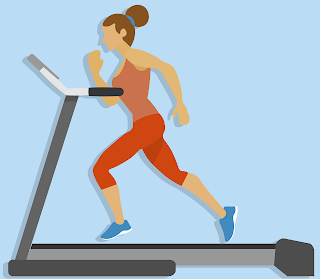Why aren't you working out on a treadmill?
Why aren't you working out on a treadmill?
Treadmills have grown in popularity throughout the years. They are especially intended to improve the most common forms of exercise - running and walking. Treadmills work on the principle that the more effort you put in, the more you receive out. Treadmills are becoming more popular and effective as other workout equipment fads come and go.
Running and walking are the two most common types of exercise. A treadmill can meet your workout demands whether you are a casual walker or a professional runner. Set the pace and incline to meet your cardiovascular objectives. You may conduct a power walk up an incline or a high-intensity run.
For a cardiovascular exercise, the treadmill is unrivaled. It engages your body's big muscles. A recent research found that calories burnt on the treadmill for 60 minutes averaged 865 – 705. In comparison, the stair machine (746-637), rowing machine (739-606), stationary cycle with levers (709-509), cross-country ski machine (678-595) and stationary cycle (709-509) (604-498). As the numbers show, the treadmill is unrivaled in terms of calorie burn.
Treadmills for exercise will provide a fantastic workout regardless of the weather. You don't have to worry about heat exhaustion in hot and humid weather if you live in a warm or rainy environment.
Treadmill users minimize or dramatically lessen injuries that affect runners and walkers as a result of the repeated hammering of joints on asphalt and concrete. Injuries are less common, and the load on those important joints is decreased. Achilles tendons, knee joints, back muscles, ankles, and thighs endure less punishment, ensuring that you can walk or run into old age.
The variety of the workout increases as treadmills get more advanced. Speed and inclination have always been options on motorized treadmills, but now you can supplement your workout with a number of preprogrammed electronic activities. Simulate jogging up and down hills, concentrate on aerobic workout, burn calories, or work on speed training. Treadmills frequently feature pre-programmed routines with varying levels of intensity. You may also create your own exercise by blending speed and incline.
A good treadmill strikes a balance between power, stability, and enjoyment. Your ability to select the ideal machine will be determined by why you want one and how much you are willing to pay. Purchase the greatest computer you can afford, keeping the following things in mind:
High alloy steel frames are often more durable than aluminum frames, but they are heavier and must be coated to keep the treadmill from rust. Get on the treadmill; if it feels shaky and fragile, it probably is. Choose a welded frame over a bolted one and stay away from all plastic frames.
Hand rails
The placement of the hand railings is a personal decision. Whether you want a handlebar in front or two side rails, make sure they're strong and don't obstruct your arm swings.
AC or DC Motor
Although most residential units are DC, business treadmills can use either AC or DC motors. AC motors are often louder and require a separate power connection.
Horsepower
Look for the continuous-duty rating to determine the real horsepower of the motor. Anything less than 1.5 continuous-duty horsepower will wear out rapidly.
Most treadmills have a speed range of 0 to 10 mph. A decent machine will match the speed at which you are comfortable walking or jogging. A safe beginning speed of 0.5 mph or less is also critical for safety.
Belt
Make sure the walking/running surface is long enough to accommodate your longest stride. The belt's width should be no less than 16" to allow for wear and tear as well as comfortable striding. Check that you can access the treadmill controls without stepping on the motor housing.
The treadmill's deck is one of its most important quality components. Quality decks should require little maintenance and function at a low temperature.
Impact Resilience
The treadmill's capacity to withstand the force of your feet's impact. The less stress you put on your body, the healthier.
Adjusting the Inclination of a Treadmill
There are several techniques for adjusting the incline of a treadmill, ranging from the automated incline, which varies based on your heart rate, to pushing a bottom on the console, to the less complex means of a manual hand crank or manually placing pins. At whatever grade, a quality electronic incline adjustment should not be loud or cause the machine to wobble.
One of the most significant quality components of a treadmill is its deck. Quality decks should be low-maintenance and operate at low temperatures.
Impact Resilience
The treadmill's ability to endure the impact of your feet. The less stress you place on your body, the healthier it will be.
Treadmill Inclination Adjustment
There are numerous ways to alter the slope of a treadmill, ranging from the automatic incline, which fluctuates based on your heart rate, to pushing a bottom on the console, to the less sophisticated means of a manual hand crank or manually putting pins. A decent electronic incline adjustment, regardless of grade, should not be noisy or cause the machine to shake.
Price
You get what you pay for, like with most things in life. A high-quality motorized machine will cost you $1,000 or more. Spending this much money should inspire you to conduct your research and make sensible purchases.
It is critical to establish a consistent habit for oneself. The more time you devote to exercise, the more calories you will burn and the more weight you will lose. Find a workout routine that works for you. You might combine your workout with music, television, or videos, depending on your preferences.
